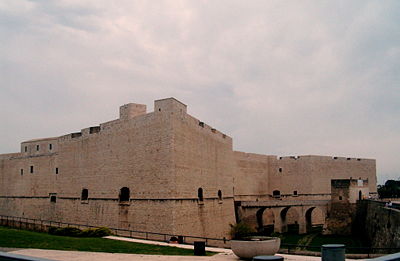BARLETTA
Situated in the Southern part
of the Manfredonia Barletta Gulf, it links its existence to
the Adriatic Sea.
In fact, it developed as a Canosa port during the Roman era,
known as Bardulos or Barulum, even though its true origin
dates back a few hundred centuries previously, as demonstrated
by finds of a Apulo settlement (4th Century).
During the Second Punic War, the Carthaginian General Hannibal,
heavily defeated the Roman army in Canne (Cannae) (216 BC)
on its territory.
Today, one can still see some of the remains of Canne (Cannae)
which was destroyed by Robert Guiscard during the 12th Century.
Barletta therefore developed as the port of Canosa for the
entire Roman period and during the 4th Century the wharf was
constructed and which still remains today.
With the spread of Christianity, the first cult building was
erected and from 584 to 590, Barletta gained part of the citizenship
of Canosa, in escape from the decline in Italy of the Longobards.
Having passed hands to Constantinople with the Greek-Gothic
War (535-553) and included in the Western estates, Barletta,
like all of Puglia, knew a period of recession in addition
to continuous clashes between the Longobards and Byzantines
and Saracen raids, who arrived via the Mediterranean Sea and
neighbouring Sicily and which they conquered during the IXth
Century.
The Normans then participated in the clashes, firstly at mercenaries
at the service of the Longobards and then as escort of the
faithful in visit to the religious centres in Puglia. They
then took on a political role gaining rights over the territory
which led to a progressive conquest of the region (first half
of the 11th Century).
With the advent of the Crusades (12th and 13th Century), Barletta
became a stopover for the Crusaders on their long journey
to the Holy Land, as also happened to the Emperor Federick
II, who before leaving, reunited Parliament of the Barons
(1228).
Previously Barletta obtained the title it of City from Tancredi
d'Altavilla and became an Episcopal Seat (1190) at the hand
of the Archbishop of Nazareth, in escape from the Muslims.
The fall of the Swabians at the hand of the Angioini, for
Barletta coincided with a period of maximum economic development,
due to strong commercial growth with the East. This was supported
by a large fleet of commercial transport ships (14th and 15th
Centuries).
The City saw the coronation of Ferdinand I of Aragon on 4th
February 1459.
With the return of the French and the inevitable clashes with
the Spanish, Barletta was protagonist of one of the most famous
clashes of the time: the Disfida di Barletta (Challenge of
Barletta). There were 13 Italian Cavaliers, commanded by Ettore
Fieramosca on the Spanish side against 13 French ones captained
by Guy de La Motte, culprits who had denigrated the value
of the Italian military. The clash took place between Corato
and Ruvo in Puglia and saw a French defeat (13th February
1503).
In 1528, French troops, commanded by Lautrec, besieged the
City, which couldn’t resume its previous stance, also
due to earthquakes and pestilence which plagued it during
the 17th Century. It wasn’t until later when it adhered
to the Republic of Naples and then joined the Reign of Italy
(1860) that it began to have new life.
During the Second World War, the City was honoured and awarded
the Gold Medallion of Military Valour.
Today, Barletta is a seaside touristic locality of great importance,
with equipped lidos, but its artistic patrimony is undeniable:
the magnificent Swabian Castle built on the wishes of Federick
II during the 13th Century, the Romanesque Basilica of Saint
Sepolcro, the Romanesque-Gothic Cathedral and its beautiful
historical centre, where one can admire noble buildings and
walk through the Medieval district.
An unquestioned symbol of the City is however the Eraclio
Colossus, a bronze statue from the Roman period which incredibly
has remained intact until now, depicting the Emperor Valentiniano
I or Marciano.
On the outskirts of Barletta one can visit Canne della Battaglia,
the area where the Carthaginians and Romans battled during
215 BC.
|
